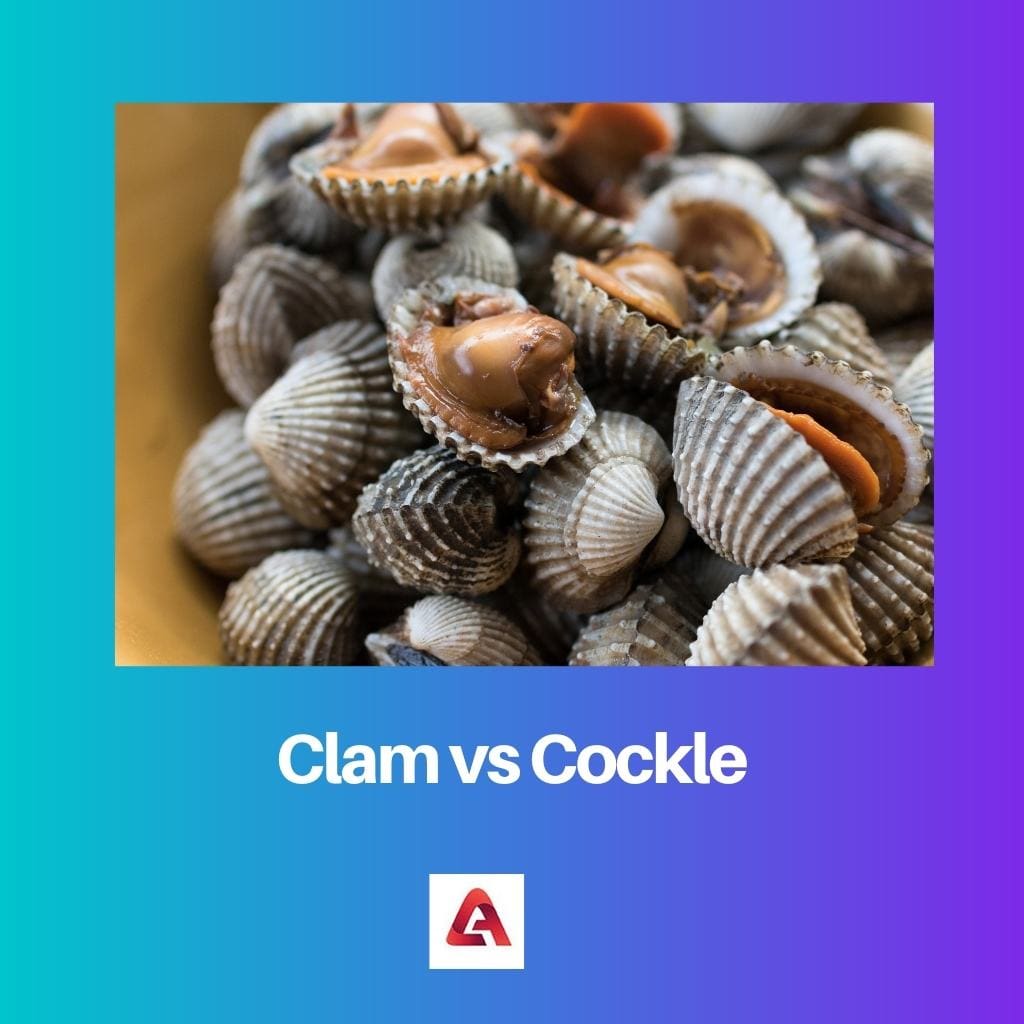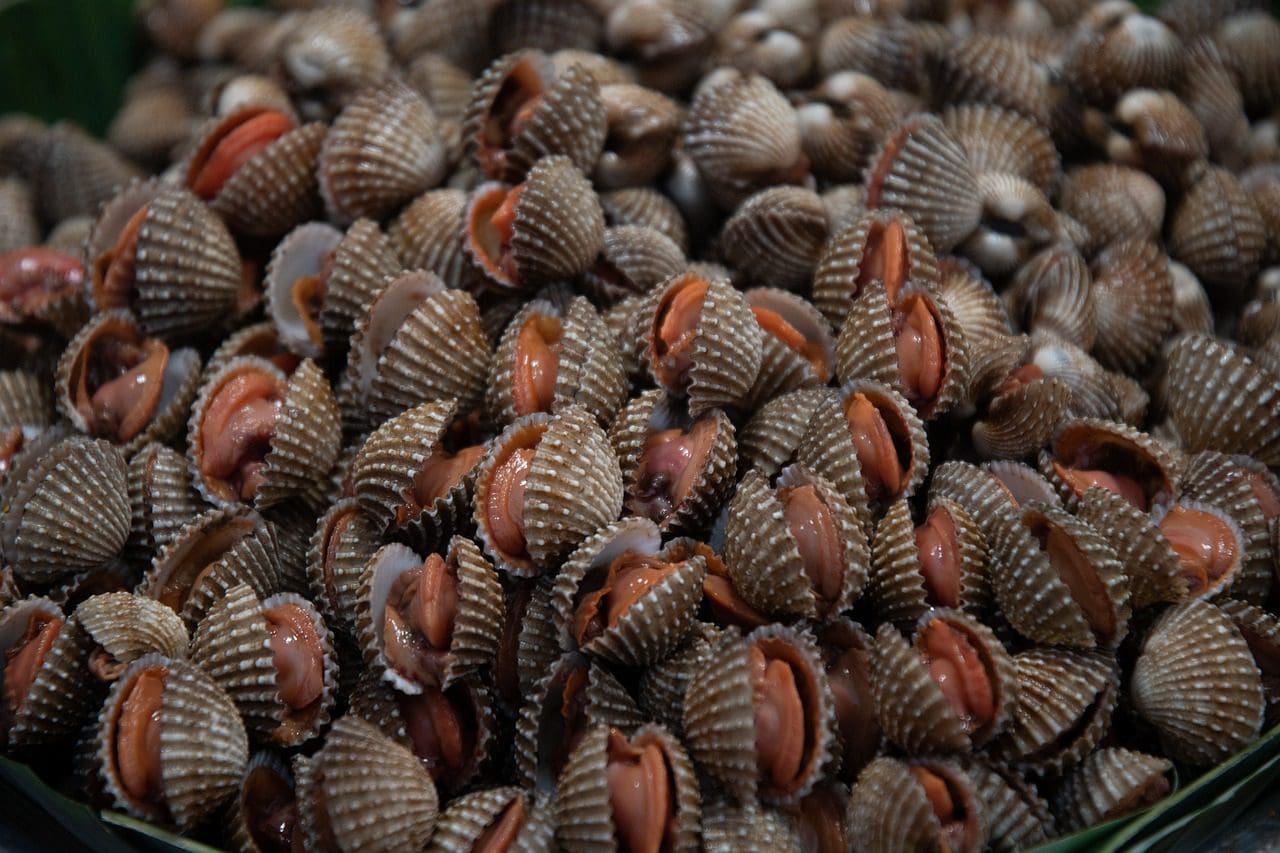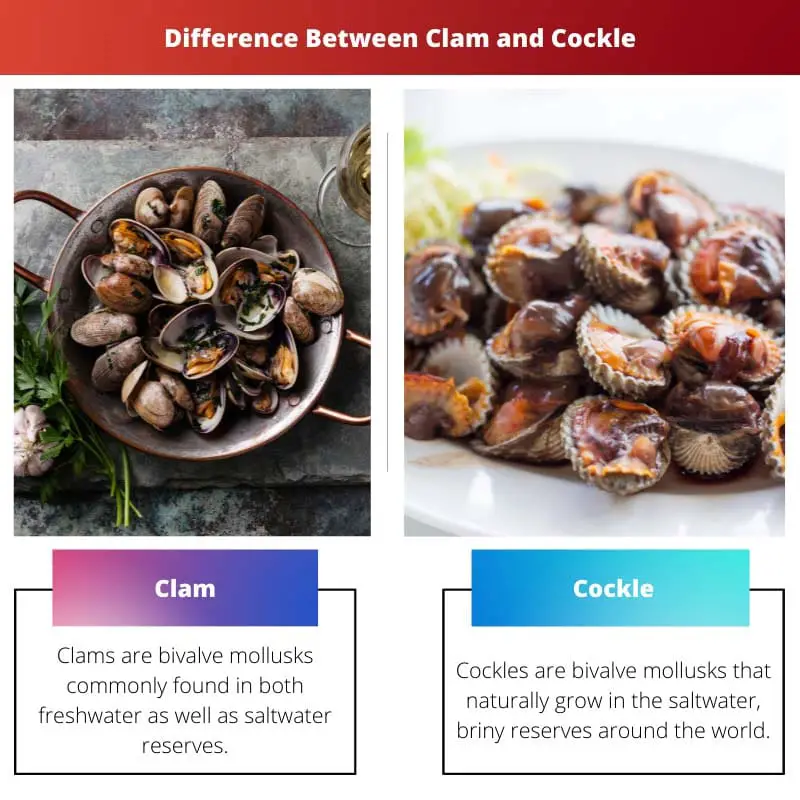In terms of the habitat of each, clams are found closer to the seashore, while cockles are commonly found scattered on the seabed in significant abundance.
This seminal difference is further exemplified in the other dissimilarities embodied by these two varieties of molluscs.
Key Takeaways
- Clams are bivalve mollusks with oval or heart-shaped shells, while Cockles are bivalve mollusks with round or heart-shaped shells.
- Clams live in saltwater and freshwater environments and have a smoother texture than Cockles, which live in sandy areas and have a grainy texture.
- Clams are larger than Cockles, with a more elongated shape, while Cockles are smaller and rounder.
Clam vs Cockle
Clams are larger than cockles, with a hard, protective shell that is darker. Their muscular foot allows them to burrow into the sand or mud. Cockles are smaller and have a more delicate shell that is lighter in colour. They are found in shallow waters.

Clams can thrive in both types of water bodies. However, cockles can only survive in the salty waters of certain reservoirs. They are not found in freshwater reserves.
Comparison Table
| Parameters of Comparison | Clam | Cockle |
|---|---|---|
| Habitat | Clams are bivalve molluscs commonly found in freshwaters and saltwater reserves. | Cockles are bivalve molluscs that naturally grow in saltwater and briny reserves worldwide. |
| Shape | The shell of a clam can be oval, rectangular, or elongated. | Cockles have distinctive heart-shaped shells that are covered with slightly ribbed patterns. |
| Extend of categorization | Clam is a broader category of classification. | Cockle is a narrower category of classification. |
| Location in the Sea | The clam can be found closer to the seashore. | Cockles are commonly found closer to the sea bed. |
| Raw Consumption | Clams can be consumed in their raw state. | It is imprudent to consume raw cockle. They should be cooked thoroughly or steamed to obtain the best results. |
| Size | Clams are larger than cockles. | Cockles are much smaller than clams. |
| Exclusivity | All clams are not cockles. | All cockles are clams. |
What are Clams?
The variety of shellfish sold in the market is truly boundless. Clams are among the most well-known and beloved shellfish at seafood restaurants globally.
These bivalve mollusks occur naturally in freshwater reserves around the world.
The term ‘clams’ functions as a broader classification category as it includes all the other varieties of bivalve mollusks within its folds.
Clams are available in different shapes and sizes. Their bodies are protected by a strong exoskeleton in the form of a shell. A clam’s shell comprises two equal sections that are joined together.
The soft body that remains secured inside the shell does not have a mouth or a head.
However, these mollusks have an internal renal system, a circulatory system, a mouth, and a heart. Clams use siphons for breathing and are commonly found in the sandy or muddy regions of the reservoir.
They can be consumed in their raw state; however, they taste best when baked or boiled.

What are Cockles?
Cockles are identified as a distant relative of the familial clam order. They are found in briny waters around the world. The cockle category of bivalve mollusks is much smaller than clams.
They are located closer to the sea bed.
Cockles also have a strong exoskeleton to protect their soft interiors. A cockle’s distinctive shell shape and appearance sets it apart from the rest of the shellfish variants.
The heart-shaped cockle shell features quite distinct ribbed patterns. Other shellfish variants can never replicate these patterns.
Cockles thrive on the sandy and muddy areas around the briny waters and feed on plankton to grow. These mollusks taste best when cooked thoroughly.
Meticulously washing them is important before beginning the cooking process. This eliminates the excessive sand from their shells.
They can be fried, steamed, or boiled. However, consuming raw cockle can cause severe health ailments.

Main Differences Between Clam and Cockle
- The main difference between a clam and a cockle is that the former bivalve mollusks can be found in fresh and saltwater environments. In contrast, cockles can only be obtained from saltwater bodies. They are briny mollusks that thrive within a saltwater habitat.
- The word clam is used as a broad classificatory term, while cockle is used in a much narrower sense.
- The overall shape of each mollusk’s shell is also quite different. Cockles have an oval or heart-shaped, slightly ribbed shell. Their shells have distinctive patterns that easily differentiate them from clams. Conversely, clams occur in a variety of shapes and sizes. They can be triangular, oval, or elongated.
- Cockles are commonly found closer to the bottom of the sea, while clams are found closer to the surface. Clams do not live near the sea floor.
- Clams are fit to be consumed raw. However, consuming cockle raw is not very advisable. They taste best when steamed and served with a butter and lemon dressing. Consuming cockle raw may lead to serious health issues.
- The size of each of these bivalve mollusks also sets them apart from one another. Cockles are much smaller than clams.
- All cockles are clams, as they belong to the clam family. However, all clams may not be cockles, as other clam variants occur naturally.





